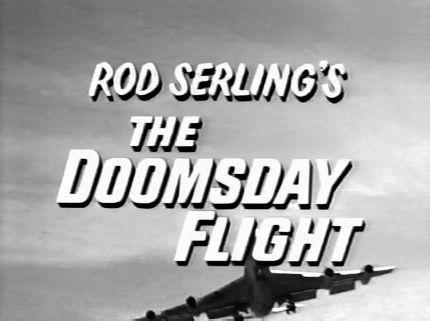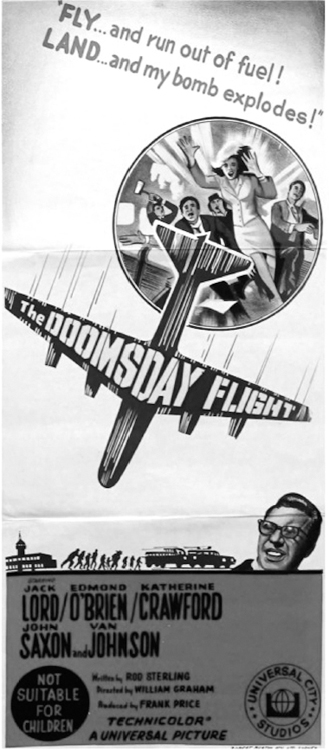
Odd Street and The Doomsday Flight
THE TWILIGHT ZONE SEQUEL THAT NEVER WAS
In October 1965, while continuing to pursue avenues to revive The Twilight Zone, Rod Serling submitted to CBS a one-hour pilot for a proposed anthology series, Odd Street. Each episode of the series would have opened with the camera eye leading the viewer down a nighttime street in a seemingly normal town. A clock tower in the town square strikes hour 13; the camera eye spins to face a store window where a calendar reads “February 31”; a generic cardboard eyeball in the window of an optometrist’s office suddenly closes its lid; a florist advertises Venus flytraps, one of which spreads its leaves to reveal a human hand inside. Interspersed with these images is Serling’s narration:
You’ve walked this thoroughfare before—on occasion—most of you. Maybe in a dream … maybe in a nightmare. Maybe in the haunting half-sleep when a man slow motions his way across an almost but not quite familiar landscape where reality goes tilt and a commonplace recollection takes on a new dimension of tension … or fear … or strangeness. So for the next hour, why not take a stroll. Just a short walk around the block. Do a little window shopping if you will … but watch what you purchase. This is Odd Street.
The network officially rejected Serling’s pilot script, “The Doomsday Flight,” on December 10, 1965, claiming that the plot was too similar to that of another pilot under consideration, Nightwatch. There is no record that Serling prepared any other outlines or story ideas for the proposed series. However, Serling subsequently expanded The Doomsday Flight to feature length, and it was produced and broadcast as one of the first made-for-television movies. The broadcast attracted big ratings—and big troubles.
THE DOOMSDAY FLIGHT
December 13, 1966, NBC
Alternate titles/productions/publications:
1. Working titles: “Odd Street: The Doomsday Flight” and “Project 120: The Doomsday Flight”
Produced by Frank Price
Directed by William A. Graham
Cast: Jack Lord: Special Agent Frank Thompson; Edmond O’Brien: The Man; Ed Asner: Feldman; John Saxon: George Ducette; Katherine Crawford: Jean; Van Johnson: Captain Anderson; Richard Carlson: Chief Pilot Bob Shea; Don Stewart: Charlie; Tom Simcox: Flight Engineer Chipps; Michael Sarrazin: Army Corporal; Malachi Throne: Bartender; Robert Pickering: Willoughby; Jan Shepard: Mrs. Thompson; Gregg Morris: FBI Agent Balaban; Howard Caine: Los Angeles Dispatcher; Edward Faulkner: Co-Pilot Reilly; John Kellogg: Seaton; David Lewis: Mr. Rierdon; Celia Lovsky: Elderly Woman; Dee Pollock: Speedi-Jet Messenger; Don Wilbanks: Bomb Disposal Man
Synopsis: International Flight 6 has received a bomb threat. Somewhere on board is an aneroid bomb—an explosive device triggered to respond to changes in atmospheric pressure. The bomb activated itself at takeoff and will detonate once the plane descends below four thousand feet. In exchange for revealing the bomb’s location, the terrorist demands a paper bag filled with one hundred thousand dollars, which a messenger will pick up and deliver to him.
Captain Anderson’s crew frantically searches for the bomb while the airline hands over the payoff. But the package never reaches its destination. The messenger van crashes en route, and the van catches fire and explodes, burning up the money. The terrorist, a twitchy, myopic little man with a heart condition, sits in a local bar, drinking heavily and thinking he’s been betrayed. But he now realizes that his plan was never about the money. It was about the feeling of power. With each drink, he reveals a little more to the bartender, first about his lifetime of perceived slights and then about how he’s finally proved that he was more than a lowly airline mechanic. During his rant he suffers a heart attack. While he is incapacitated, the bartender calls the airline to share his suspicions, but by the time the FBI shows up, the man is dead, and they are no closer to discovering the bomb’s location. Running out of fuel, Captain Anderson has no choice but to attempt a landing. When the tower provides a list of airports within range, Anderson recognizes one potential lifesaver: Denver, Colorado—altitude 5,250 feet above sea level. They have just enough fuel to reach it and land safely without detonating the bomb.
Once on the ground, Anderson and his crew catch their breath while a bomb squad combs through the plane. They do not find a bomb—but Captain Anderson does. It’s in his carry-on, where it had been planted while his bag was briefly out of his sight at the airport.
Notes: The title card for the movie reads “Rod Serling’s The Doomsday Flight.” In hindsight, Serling would wish he had not claimed ownership of the film. This regret had little to do with the film’s quality, however.
In the week immediately following the film’s premiere, the Federal Aviation Agency reported as many bomb hoaxes as had occurred during the previous month. In August 1970, apparently inspired by a repeat showing of the film, a man contacted Western Airlines to claim that he had planted a pressure bomb on a flight from Anchorage to Seattle. In May 1971, both National Airlines and Qantas Airlines received bomb threats almost identical to those in the film. Shortly after the film was repeated in Canada on July 26, 1971, a British airline received a call from a man claiming to have planted a pressure bomb aboard a flight from Montreal to London. In this case, the pilot copied the film’s answer to the threat, landing the plane in Denver. No bombs were found on any of these flights. Shortly thereafter, the Federal Aviation Administration asked television stations in 150 cities not to show the film again. Several stations complied, but another pressure bomb threat occurred in 1972, this time regarding a TWA flight from Madrid. Again, no bomb was found. All told, the airlines paid at least $585,000 in ransom demands. “I have done a vast disservice to the airline industry,” Serling said. “I didn’t realize there were so many kooks in the woodwork. I wish to Christ I had written a stagecoach drama starring John Wayne instead. I wish I’d never been born.”1
Serling’s brother, Robert, worked in the aviation industry for most of his life, and frequently wrote about and lectured about air safety. Robert Serling gave his brother the initial story idea:
I had heard from an American Airlines captain about a bomb hoax where a pressure bomb had [allegedly] been aboard an American 707 and it was set to go off if he descended below [a certain altitude]. And the captain, very wisely and smartly, says “Screw him, I’m gonna land in Denver.” Which he did. When I got that story from the American Airlines captain, I did not use it. I was with [United Press] at the time, and I said I’m not gonna use it because somebody’s gonna get an idea to pull the same damn thing if he sees it in print. I thought it was a blueprint for another hoax of the same kind.
Rod held onto the idea for several years before giving in to temptation and writing The Doomsday Flight, and according to Robert, “To his dying day he regretted it.”2
Rod Serling’s final piece of professional work was the narration for a documentary, Takeoff: The Airline Story, written by his brother.3 The documentary, released after his death, includes a forgiving postscript: “The men and women of the airlines dedicate this film to the narrator, Rod Serling, a true friend of aviation.”
The Doomsday Flight is a well-plotted thriller that presaged a minor wave of airline disaster movies that began with 1970’s Airport and effectively ended with the 1980 spoof Airplane! While the plot of the film is not conducive to making any deep, philosophical statement, Serling populates the story with characters that qualify as Serling-esque, including a shell-shocked Vietnam veteran (who regains his composure and displays courage at a key moment), a vain Hollywood actor (who gets his comeuppance), and an airline captain who isn’t ashamed to admit that he’s afraid. And in typical Serling fashion, the villain is “captured” not by heroic FBI agents but by an ordinary bartender, again displaying Serling’s affection for the common man.
Serling’s compassionate nature and his desire to project this quality onto his characters is particularly on display in a scene between the bartender (played by Malachi Throne) and the unnamed villain (Edmond O’Brien). In the scene, O’Brien has not yet revealed that he is dangerous, but he’s clearly unhinged, and he previously snapped at the bartender when he attempted to make conversation. Now he’s the only customer in the place, and the bartender wants to close up early. Trying to convince the man to leave, the bartender becomes increasingly annoyed until the man exhibits signs of a heart attack. The bartender immediately becomes genuinely concerned, asking about the man’s health, commenting on his medications, and offering to get him a drink of water. Another writer might have had the character react with further annoyance or callousness (the potential dialogue suggests itself: “Hey, don’t you die in here, buddy! It’s two o’clock in the morning already, if you drop dead I’m never getting out of this place!”), but Serling grants this man a measure of humanity and grants the villain a measure of dignity.

The Doomsday Flight was released theatrically in Europe.